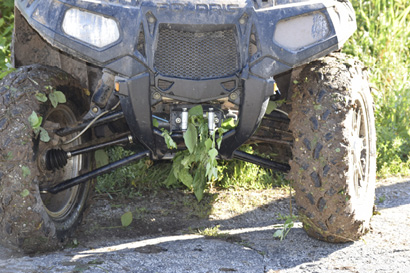Often used for scouting purposes, ATVs make many visits to numerous fields over a growing season, increasing the probability of inadvertently transporting unwanted biomaterial from one field to another. This material may attach itself to the undercarriage, steering components, tires, and parts of the frame, particularly in tight spaces underneath and on the frame of the vehicle.
While it is unlikely that operators will be able to remove 100% of the biomaterial from a vehicle, it is possible to reduce the risk of spreading material from one field to another by taking a few minutes to follow these simple clean-up steps:
1. Remove all plant material, living and dead. Some weed species produce up to 500,000 seeds per plant, and species like Palmer amaranth and waterhemp hold their seed very tightly, making accidental spread with
plant material likely.
2. Remove loose clods of soil accumulated on tires, wheel wells and fenders. Soil transported from one field to another may contain potential weed seed and other pests, like Soybean Cyst Nematode (SCN). Once SCN becomes established in a field, it cannot be removed and often becomes a lifelong management issue for the landowner.
Once the unit leaves the field, assess the situation for risk of transporting biomaterial and soil offsite.
Identify problem areas before moving on to the next field.
Remove as much plant and soil material as you reasonably can to limit unintended transport.
While you may not be ablet o remove 100% of the material...
...any amount of biomaterial you prevent from spreading field to field can be significant.




